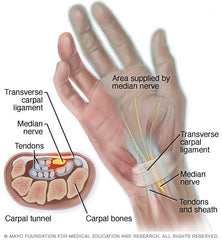IASTM for Carpal Tunnel Syndrome
Background:
Carpal tunnel syndrome is a characterized by tingling, burning, pain or weakness in the areas supplied by the median nerve, particularly over the thumb, index, and middle fingers and radiating up the arm. It is caused by compression of the median nerve as it passes through the carpal tunnel. (1).
T he carpal tunnel is a structure on the palmar side of the wrist formed by a bony floor and a ligamentous roof through which nine tendon pass accompanied by the median nerve (2). This congested tunnel poses a problem when it's space is decreased from any number of reasons from overuse, inflammation, arthritis, pregnancy, hypothyroidism, and others. When the tunnel’s size is decreased the median nerve can become compromised and irritated resulting in symptoms(3).
he carpal tunnel is a structure on the palmar side of the wrist formed by a bony floor and a ligamentous roof through which nine tendon pass accompanied by the median nerve (2). This congested tunnel poses a problem when it's space is decreased from any number of reasons from overuse, inflammation, arthritis, pregnancy, hypothyroidism, and others. When the tunnel’s size is decreased the median nerve can become compromised and irritated resulting in symptoms(3).
 A 2007 study by Burke used a protocol including IASTM treatment that was shown to effectively improve median nerve function, wrist strength, and wrist motion in a group of carpal tunnel syndrome patients (4).
A 2007 study by Burke used a protocol including IASTM treatment that was shown to effectively improve median nerve function, wrist strength, and wrist motion in a group of carpal tunnel syndrome patients (4).
IASTM for Carpal Tunnel Syndrome:
The following is a proposed treatment protocol for addressing dysfunction related to carpal tunnel syndrome.
- Assess active and passive range of motion of the affected areas (fingers, wrist, elbow) and identify limitations in motion or symptomatic movements
- Apply lotion or emollient to the palmar surface of the hand, forearm, and elbow
- Using the long concave surface of an IASTM tool, gently scan using long superficial strokes along the anterior surface of the forearm, bicep, and wrist; scan over the thenar and hypothenar eminences using a small concave surface
- Identify areas of increased fascial restriction or muscular hypertonicity that should be treated
- Begin treatment first with superficial strokes, and then deeper strokes using patient comfort and your assessment of tissue quality to guide the intensity/duration of treatment
- Treatment over the carpal tunnel can be done using a peeling stroke that splays out medially and laterally from the carpal tunnel into the thenar and hypothenar eminences
- Using patient comfort and tissue tone/texture as a guide, you may incorporate active or passive movements into and previously identified limited ranges of motion in the fingers, wrist, forearm or elbow
- Reassess active and passive movements of the affected structures to identify changes in range of motion
- Patients should be given appropriate home stretching, nerve flossing, and ergonomic modification to help to encourage healing and minimize strain to the affected structures
This post is for informational purposes only and is not intended to represent medical advice. Please consult a qualified health practitioner for assessment and management of any concerns you may have.
- Carpal Tunnel Syndrome, Wikipedia (https://en.wikipedia.org/wiki/Carpal_tunnel_syndrome).
- Carpal Tunnel Syndrome Fact Sheet, NINDS, Publication date April 17, 2015.(http://www.ninds.nih.gov/disorders/carpal_tunnel/carpel_tunnel_FS.pdf)
- Thieme Atlas of Anatomy: General Anatomy and Musculoskeletal System. Thieme. 2006. pp. 248–249
- Burke J, Buchberger DJ, Carey-Loghmani MT, Dougherty PE, Greco DS, Dishman JD. A pilot study comparing two manual therapy interventions for carpal tunnel syndrome. J Manipulative Physiol Ther. 2007 Jan;30(1):50-61.
